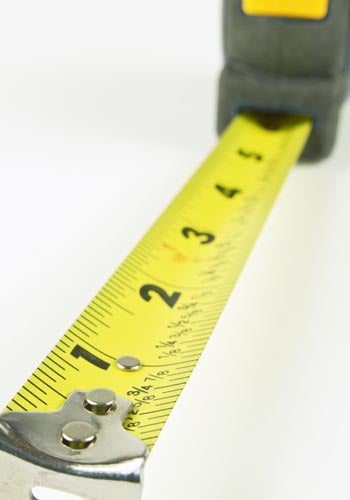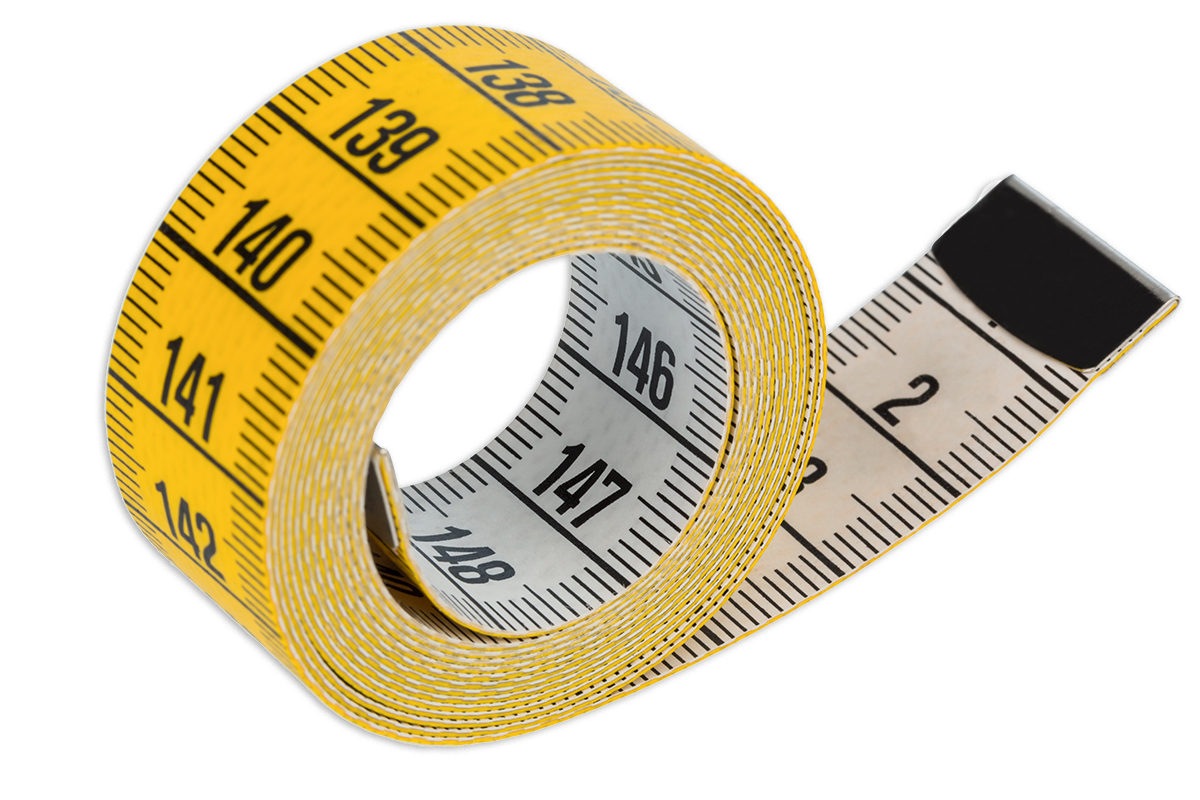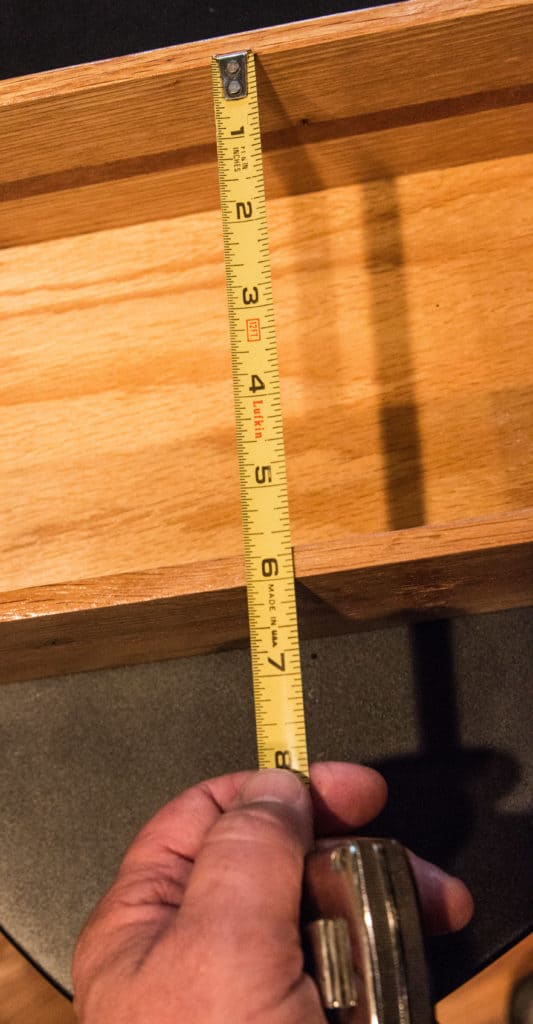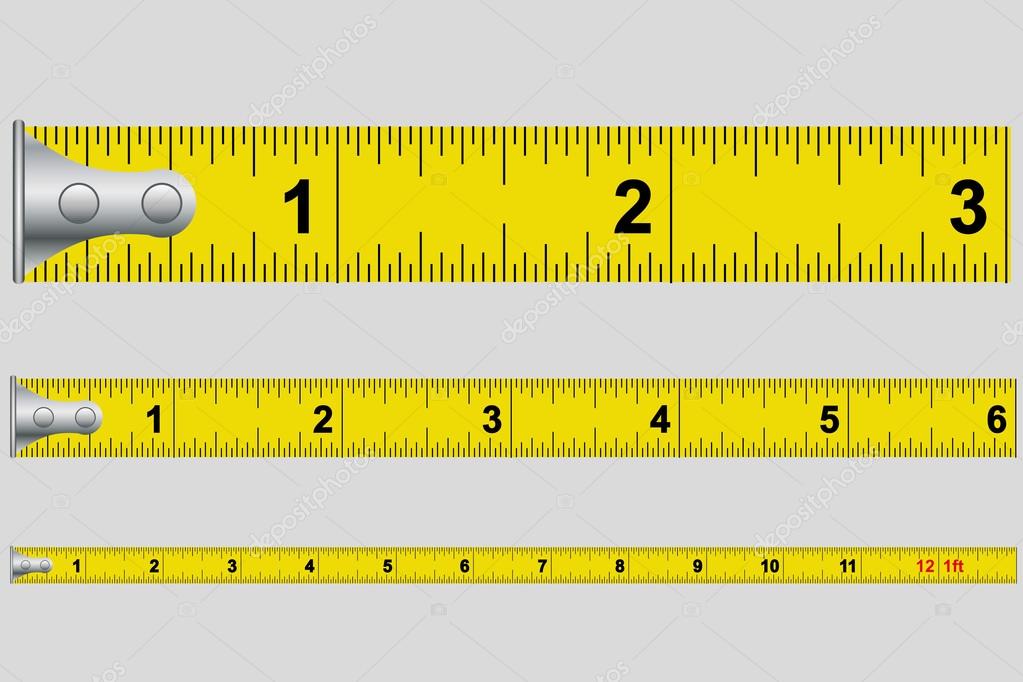Tape measures are often designed for specific uses or trades. Tapes may have different scales, be made of different materials, and be of different lengths depending on the intended use. Tape measures that were intended for use in tailoring or dressmaking were made from flexible cloth or plastic. These types of tape measures were mainly used for the measuring of the subject's waist line.
Today, measuring tapes made for sewing are made of fiberglass, which does not tear or stretch as easily. This type of tape measure will have a floating tang or hook on the end to aid measuring. A tape measure of 25 or even 100 feet can wind into a relatively small container.
The self-marking tape measure allows the user an accurate one hand measure. With linear-measured markings usually covering a number of different scales, a measuring tape can be many different materials. Flexible fabric options are great for accurate measurements across circular or jagged surfaces.
Measure tapes often have a floating tang or hook at the end, sometimes magnetic, to secure them in place when in use which is ideal if working alone or in awkward spaces. In some countries such as the UK, tape measures have both Imperial and Metric measurement markings. Until recently in the US, for example, all tape measures were in Imperial units, however the dual standard option is becoming more widely available. Reading a tape measure correctly is a necessary skill when taking on DIY projects. Tape measures are available in both standard or imperial units and in metric units.
This guide will show you how to read a tape measure. Plus, you'll learn some tips and tricks for using this tool to get precise measurements. Building and construction practice calls for all measurements to be made in millimeters . These are the smallest unit on the tape measure scale, and are also marked with the smalles hash mark along the edge. As they are so small, they are generally not individually numbered on tape measures.
Ten millimeters make up a centimeter and these are marked with a number, and a bigger hash mark. Every tenth centimeter is highlighted, so they can be easily picked out. A hundred centimeters make up a meter , which is again clearly marked on a tape measure with a hash mark that will extend across the width.
A tape measure, or measuring tape is a type of hand tool typically used to measure distance or size. It is like a much longer flexible ruler consisting of a case, thumb lock, blade/tape, hook, and sometimes a belt clip. A tape measure will have imperial readings, metric readings or both. They are a common measuring tool used in both professional trades and simply around the home.
Measurements On A Tape Measure Mm Reading a tape measure is a skill you can easily master. Using this small, sturdy hand tool can improve the accuracy of your project measurements. Learning how to use a tape measure properly means to always "measure twice, cut once." You can use a standard tape measure or opt for a metric one. The Home Depot delivers online orders when and where you need them. To read a measuring tape, line the zero mark up at the edge of the item you're measuring, then stretch the tape all the way across the item.
Try to keep the tape straight to ensure an accurate measurement! Then, look at the point where the tape meets the end of the item you're measuring and read the nearest large number. The large numbers are the units you're measuring, like inches or centimeters, and the markings between the large numbers correspond to fractions of that unit. The use of millimeter only tape measures for housing construction is a part of the US metric building code.
Millimeters produce whole numbers, reduce arithmetic errors, thus decreasing wastage due to such errors. The sale of dual Metric/US Customary scale measuring tapes is slowly becoming common in the United States. For example, in some Walmarts there are Hyper Tough brand tapes available in both US customary units and Metric units. So, the inclusion of a metric scale requires the measuring device either to contain 3 scales of measurement or the elimination of one of the US Customary scales.
In the image below a pocket tape measure is presented, in which generally, they use the metric and imperial system on the same sheet. The measurements at the bottom of the tape are metric units, they are in centimeters and millimeters . There are 10 mm in each centimeter and 100 cm in each meter. Starrett long and short measuring tapes and Measure Stix™ are offered in a wide range of styles and sizes. Graduations are available in English and Metric to meet virtually every requirement for accurate tape measurement. Introducing the new series of Starrett, Starrett Exact® and Starrett Exact® Plus.
Imperial measurement can be a bit tricky, especially or those who have been brought up using Metric measurement. The Imperial measure used extensively in the US, is split to feet, inches and fractions of an inch. The next is the 1/8th of an inch with a slightly longer hash mark. These are longer again, and 2/8ths, 4/8ths, and 6/8ths are marked as quarter inches.
The ½ inch is marked with a yet longer hash, and then each inch is marked with a hash that runs across the width of the measure, and a number. As we know, 12 inches make up a foot, and these are marked with 1F, 2F, 3F, and so on. Sometimes you will find that on one edge that after the foot marker, the inches will increase again by single digits to reach 12 for a the next foot.
On the other edge the inches will keep numbering incrementally, so 1ft 2 inches will register as 14 inches, and so on. At three feet, for example, it would measure 36 inches. For measurements on construction sites or in industry, tape measures made of steel or glass fiber plastic are mainly used. If the model is made of steel, the scale is not printed on, but is usually engraved – so it cannot wear out. Depending on the length, the scale shows units such as meters, decimeters, centimeters and millimeters. Just as you would with a retractable tape measure, look for the spot where the end of the object or distance you're measuring lines up with the tape measure.
If the tape measure stretches exactly halfway between the 27 and 28 inch markings, this means that your arm is 27.5 inches long. The markings on a tape measure are in both metric meters and centimeters as well as imperial units which are feet and inches. BMImeter pocket tapeIt is not just the fantastic design that distinguishes this tape measure, but also it's extreme practicality. This tape is especially useful when measuring and marking on a wall because it is very stable.
The round, open housing is also very light so that the tape held on the wall won't kink and fall away. It can also be held easily in place to mark the distance needed. The tape, in white painted stainless steel, is waterproof, unbreakable, light and very durable. Above you'll see a picture of a metric/imperial pocket tape measure.
The measurements towards the bottom of the image are metric. In other words, they're in centimeters and millimeters. On a tape measure labeled with imperial units, the most prominent marks are usually the one-inch marks. These are typically marked by long, thin lines and fairly large numbers. But if you DO end up needing or using a metric tape measure, know that for every meter, there are 100 cm and for every cm, there are 10 mm.
Most metric measuring tapes only mark the cm for readability, so you'll need to count the number of ticks in between to get your exact measurement. Sometimes, there are larger ticks in between each cm to denote 1/2 cm. You might be one of those people who just think the hook at the end of the tape measure is so you can easily roll the end of the reel. Well, it's a much more sophisticated than meets the eye. The hook is called the 'tang', and is attached to the blade of the tape measure using a couple of rivets.
However, if you have noticed the tang is not held in a permanent position, and floats at the end with a little give. This little piece of shaped metal, makes measuring an internal measurement just as easy as taking an external. By pushing the tang up to an internal edge it butts up tight to the end of the tape measure blade to give an accurate reading. In the United States, the imperial measurement system is normally used on a tape measure, though some models may have both the imperial and the metric system. Personally I much prefer this type of measuring tapes for sewing.
Converting lengths for sewing is simple using a tailor's tape marked in both cm and inch. All you need to do is read the inch side corresponding to the number in centimeters. If we have to convert for example 66 cm into inches, looking at the image below we can see the result is 26 inches. In metric measuring tapes, centimeters are the most significant markings.
Centimeters are generally represented by the large lines , and you will see a number next to each line. Same as inches, the line represents each centimeter. Sixteenth-inch marks are considered as the shortest lines of all measuring tapes. You will find 16 tiny marks per inches and 4 in each quarter inch. Understand that a metric tape measures use centimeters instead of inches.
Each centimeter is divided into ten sections called millimeters. All you have to do is read the larger lines and then number of millimeters of the last centimeter if the object does not measure an exact number of centimeters. A 16-foot tape measure, for example, will have sixteen one-foot marks along its length and 192 one-inch marks .
Each inch will have eight 1/8 inch marks and sixteen 1/16 inch marks. In many cases these measurements are abbreviated, so 6 ′ 4 1/4 ″ means six feet four and a quarter inches. In other words, they're in centimetres and millimetres.
There are 10mm in each centimetre and 100cm in each metre. Whilst the centimetres are clearly numbered, to make the blade easier to read the millimetres arenotnumbered. Also, whilst a few tapes show '1m' to display the 1-metre mark, the majority will show '100cm'. Although the measuring marks on most tapes are accurate, the hooks can get bent or warped over time. To verify accuracy, pull a line on a known straight edge with both tape measures and compare their marks.
Ideally this should also be done at the start of every job. But at the very least, take a few seconds to verify no serious damage has occurred if one of the tapes is dropped or otherwise abused. It consists of a ribbon of cloth, plastic, fibre glass, or metal strip with linear-measurement markings. Its design allows for a measure of great length to be easily carried in pocket or toolkit and permits one to measure around curves or corners. Today it is ubiquitous, even appearing in miniature form as a keychain fob, or novelty item. Surveyors use tape measures in lengths of over 100 m.
When I started to sew and for a long time afterwards I just knew the main marks in the tape measure. Something as basic as this should be taught in the school rather than some other nonsense that I learned in school, which I never found a use afterwards. In this age of laser measuring tapes , electronic tape measures and measuring tape apps , and easy paper patterns one may wonder at the use of the ordinary tape measures. But for me it is one of the most useful and necessary sewing tool. Align the first large mark of the metric tape measure with the bottom edge of the book. Write the number of centimeters, add a decimal point, and write the number of millimeters.
If the book measured 8 centimeters and 3 millimeters, we would say the book measures 8.3 centimeters. Metric tape measures feature 10 marks to the centimeter. The smallest marks on a tape indicate one millimeter or 1/10th of a centimeter.
The large, bold markings on a metric tape measure indicate centimeters. The long mark in the center indicates a half-centimeter. Standard or SAE tape measures clearly show feet, inches and fractions of inches. The measurements on a tape measure are generally 16 marks to the inch. Some tapes measure from 32 to 64 marks to the inch.
Laser distance measurers can often measure accurately within 1/16 inch. Use the tiny, densely-packed marks for sixteenths of an inch. The shortest lines of all on most measuring tapes are the sixteenth-inch marks. Use the same pattern for recognizing these minuscule measurements. This pocket tape measure from Shinwa with a 25 mm wide tape is designed for regular outside use under harsh conditions. The carbon steel tape is nylon-coated to protect it against moisture.
The highly effective return spring is made of carbon steel. The belt clip is separate and firmly attached to your belt, you snap the tape into this clip. It is released from the clip by pressing the top red button. Even in the most awkward position the tape will not part company with the belt clip as would be the case with more basic belt clips. Standard or SAE tape measures clearly show feet, inches, and fractions of inches.






















No comments:
Post a Comment
Note: Only a member of this blog may post a comment.